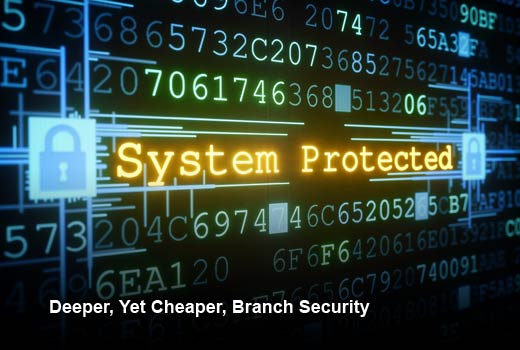When organizational budget cuts come, IT departments are often the first to get squeezed. This puts them in the unfortunate position of always looking for new and innovative ways to save on capital and operational expenses (capex/opex) while maintaining the integrity and security of their organization’s internal and branch operations. To balance lower budgets with senior management’s high expectations, forward-thinking IT department heads have begun investigating and deploying new software-defined (SD) features and services for their branch offices. And this is being enabled through the rollout of software-defined networks (SDN), software-defined WANs (SD-WAN) and network function virtualization (NFV).
Before SD features and services, IT relied on expensive proprietary hardware and software platforms that were time consuming to install, configure and train colleagues on. By the time a department had fully mastered the particular platform, new software updates would emerge that quickly made the old platform obsolete. And thus the circle of life would begin again. Thanks to SDN/SD-WAN/NFV and new SD features and services, IT departments are starting to say goodbye to this Möbius strip-like product lifecycle and hello to significant savings in product costs and usability. Last year Robert Cohen at Lens360 compiled several savings of early Fortune 500 adopters, noting that some saved millions of dollars and saw cost reductions of 95 percent!
The benefits of de-coupling software from IT hardware is not a new concept, VMware started this charge back in 1998. But it has evolved quite a bit in just the last few years with the introduction of SDN. Two years ago, Andrew Lerner of Gartner predicted that by the end of 2016, more than 10,000 enterprises worldwide will have deployed SDN in their networks, a tenfold increase from end-of-year 2014. And now Gartner’s saying this is the year that it goes mainstream.
As SDN has matured, SD features and services [also known as virtualized network functions (VNF)] have arrived to ride on top of it. A few of these emerging SD features and services include software-defined wide area networks (SD-WANs), software-defined next-generation firewalls (SD-NGFWs) and software-defined unified threat management (SD-UTM). These new and innovative products and services are poised to replace the legacy, proprietary hardware, software and technical staff required to configure, manage and maintain all of the disparate platforms in an enterprise branch office. In this slideshow, Versa Networks has identified the top five ways NFV is lowering branch office capex and opex.
From office-wide happy hours to office parties and corporate retreats, work events are often characterized by a more relaxed but professional environment, casual chats with colleagues, and include alcoholic beverages. Though these events are often a wonderful way to connect with coworkers and interact with the power-players, they can also be monumentally disastrous without modern manners.
Sharon Schweitzer, an international etiquette expert and founder and CEO of Protocol & Etiquette Worldwide, offers the Do’s and Don’ts of work event etiquette to help you enjoy the night and find the balance between personal and professional behavior.
– DO pay attention to your office culture: Many companies and their employees go out for drinks on a regular basis; sometimes after work and few may even partake during meetings or conferences. However, other company cultures may be vastly different and alcohol is prohibited. Find out what is acceptable, expected, and comfortable for you and your colleagues.
– DO make an effort to talk to lots of people: You spend the majority of your week surrounded by these people, and work events (with or without drinks involved) can be a professionally comfortable venue to get to know your co-workers better. Remember to talk to people you see every day, and also branch out to new people. By connecting with multiple colleagues from all areas of your organization, you are able to create possible mentors, references, and contacts that can help your career down the line.
– Do take a break from your phone: If you are glued to your phone all night, you will miss out on key face to face interactions with your colleagues. The snapchats and texts will be there when you are done. Also keep in mind that social media captures everything. Be aware of this when ordering another drink and possibly hitting the dancefloor.
– DO remember why you are there: Whether it’s talking to a specific superior, making new friends, connecting with people from a different department, remember why you are at the event. It’s not to take advantage of the open bar or get some free food. Keep the notion in the back of your head that this is still a professional gathering and a chance to put your best foot forward.
– Don’t loosen up too much: Although being comfortable at these events is key, don’t allow yourself to be overly comfortable. These events are an ideal avenue for colleagues to get to know more than the work-oriented facet of you. However, keep in mind that there is a thin line between sharing happy stories about your personal life and divulging inappropriate information. Remember, your superiors may be surrounding you.
– Don’t feel pressured to drink: Feeling lost due to the fact that you don’t drink? Not to worry. Always feel free to order a club soda with lime, soda or drink of your choice. Alcohol consumption should not dictate your success, but having a drink in hand and engaging in conversation with others is key. What’s in your drink is irrelevant.
– Don’t do as the boss does: Perhaps your boss really lets loose at events. This is not an opportunity for you to do the same. Whether it’s fair or not, you are still climbing the ladder and your view is not the same as the one from the top.
– Don’t talk about work the whole time: You all have one thing in common: work. However, a work-related event is not the time to keep working or discuss office gossip. Keep conversation between a professional and personal balance; classy, informative, and interesting. Asking questions about sports, movies, books, vacation, travel and pets are good topics that focus the conversation on others.
Lowering Branch Office Expenses
Click through for five ways NFV can help organizations lower branch office capex and opex, as identified by Versa Networks.
Buy Cheaper Hardware
By standardizing on commodity hardware/whiteboxes – instead of proprietary networking and security appliances – customers can slash their infrastructure capex spend. Major analyst firms cite the average cost of branch network and security devices ranges from $10,000 to over $50,000, depending on size of branch, bandwidth and connectivity types and security/compliance requirements.
Exploit Broadband Connections
Use broadband alongside MPLS to map out what apps go where on either of those cables. For example, traffic to Oracle business applications in the enterprise data center can be routed over MPLS, while access to cloud apps like Salesforce.com and Workday, and non-business Internet traffic can be routed over secure broadband. The result is lower overall WAN costs and higher performance through more bandwidth, direct cloud access and MPLS offload.
Centralized Network Policy
With automation via zero-touch provisioning and centralized management software, IT teams can manage an entire WAN and set policy from the head office. This significantly reduces the time required to manage networking and security services vs. manual management at each branch, bringing in serious opex savings.
Faster, Easier Rollouts
Rolling out large-scale SD-WAN and branch security deployments through NFV can happen quickly and without the setting up of complex or proprietary hardware. As a result, new deployments can be designed and validated in days, saving a great deal on the costly opex that typically comes with a lengthy setup period. Network IT teams can adopt an agile, software-based DevOps model and remove the provisioning time and hardware dependency of traditional WAN and security architectures.
Deeper, Yet Cheaper, Branch Security
Virtualizing branch security is just as crucial; as we’ve seen in the news, many data breaches originate from a compromised branch office. Security-in-depth is now much easier via NFV. Virtualizing the network enables companies to use virtual security services that also sit on top of commodity hardware, reducing the capex and administration associated with buying and integrating the traditional hardware options.








